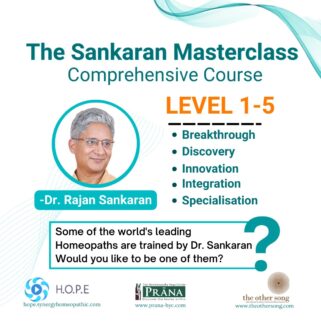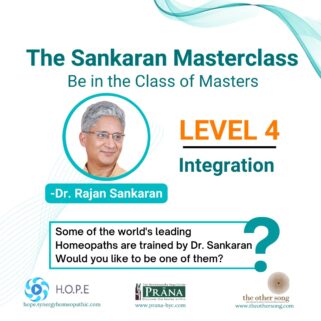Currently Empty: $0
Shop
Level 2, Discovery – The Sankaran Masterclass
MODULE 1: DR. SANKARANS ADVANCED MIASMATIC THEORY
This module discusses the concept of newer miasms whose discovery was a quantum leap in the history of Homeopathy by Dr. Rajan Sankaran. Each Miasm has a depth and pace which is seen in the different remedies classified under it, this aids our understanding of remedies and also by classifying patients according to the Miasm our search for the simillimum becomes easier.
$594
Description
MODULE 1: DR. SANKARANS ADVANCED MIASMATIC THEORY
This module discusses the concept of newer miasms whose discovery was a quantum leap in the history of Homeopathy by Dr. Rajan Sankaran. Each Miasm has a depth and pace which is seen in the different remedies classified under it, this aids our understanding of remedies and also by classifying patients according to the Miasm our search for the simillimum becomes easier.
Talk 1: Miasmatic concepts from the Acute to Malaria
In this talk Dr. Sankaran gives a brief description of all the Miasms and shares how the Miasm is a way to classify remedies and diseases. He shares about the 3 patterns and discovery of more patterns, also sharing what was Dr. Hahnemann’s concept of Miasm. This talk includes the study of the first 4 Miasms in detail being Acute, Psora, Typhoid, and Malaria.
Talk 2: Miasmatic concepts from the Ringworm to Tubercular
Continuing on from the previous talk Dr. Sankaran shares how we can classify remedies and people according to Miasms and thus use it as a tool to fine tune our remedy selection. He beautifully explains the Miasms with help of cases, analysis of the case, rubrics and follow-ups which give us a total understanding of each Miasm in detail. Ringworm, Sycosis and Tubercular Miasms are explained in this talk.
Talk 3: Miasmatic concepts from Cancer to Syphilis
The last talk of the Miasms lecture, we study the intense chaos- Cancer, Intense Hopelessness-Leprous and Hopelessness with a sense of impending destruction- Syphilis in this talk. Dr. Sankaran talks about these with case examples and also tries to explain the difference between leprous Miasm and animal kingdom which seem similar.
MODULE 2: LEVELLING UP; TAKING YOUR HOMEOPATHY DEEPER
This module focuses on the study of the levels of experience and in detail understanding of each level along with case examples
Talk 1: 7 Levels of Experience- 1
Dr. Sankaran shares the 7 levels of experience in detail along with case examples which help us understand the importance of the levels. He shares the importance and practical utility of the levels of Experience. He shares that as we go deeper into each symptom or we go one level higher the symptoms become less logical and more individual and more personal. It becomes less about the physical symptom and more about the experience, sensation, delusions the patient has along with the physical symptom. Lastly he shares the Levels and corresponding potencies for each Level.
Talk 2: 7 Levels of Experience- 2
This talk focuses on understanding the sensation level in much more detail as this is the level in which the patient expresses non-human language, the language of the source, the language of nature on the basis of which we select the remedy. With the help of cases a more clear understanding is established as to how to use this level in practice.
Talk 3: Discussion on Levels
This talk is a continuation of the last 2 talks and it consists of various cases which help us understand how to locate the level the patient is on and how to probe deeper to understand and reach the patient’s level of experience.
MODULE 3: CASE-TAKING
Case-taking is the most important subject in Homoeopathy which determines the success or failure in that given case. Dr. Sankaran discusses the same in depth in this module.
Talk 1: Exactness and Completeness in Case-Taking
In this talk Dr. Rajan Sankaran talks about the most important topic which determines the success or failure of a case which is Case-Taking. He starts by sharing the basics of Case- taking, being the case form, how along with observation we should make a detailed enquiry from the relatives, how we should look into the finest details, concomitant symptoms, mind symptoms etc. He urges us to seek to understand what is and not why it is. He shares the techniques of case- taking with the help of a few case examples.
Talk 2: Accomplishing the 1st step for successful practice
In this lecture Dr. Sankaran has given a step by step outline of the case-taking procedure. Starting by reading the salient points in the case form, and seeing what strikes us there, observing the behaviour and mannerisms of the patient, giving the patient full freedom to narrate their story, focusing on the chief complaint and asking which one is the most bothersome complaint, noting the gestures, probing the words and ideas that have energy and many more such points are discussed in this talk along with how at the end of case-taking we should be able to fully understand who the person is.
Talk 3: Step by Step Case-Taking
Continuing the case of the earlier talk, Dr. Sankaran further goes on to explain how we should not mechanically take symptoms, how we should look at 3- 4 areas and then find the commonality. Dr. Sankaran shares Dr. Sehgal’s contribution and how he developed a technique and ability to see the patient’s mind state expressed through casual expressions in the very first few minutes of the case and how our senses should be alert in case- taking to receive all inputs from observations, words of the patient, gestures, patient’s relatives who are sitting next to him etc. and lastly shares how we should identify a pattern and follow it.
Talk 4: Case- taking with help of cases
In this talk, Dr. Sankaran puts light on the areas where students and practitioners tend to make mistakes. He tries to make us aware of the errors that occur while case- taking and how to avoid them and receive a case perfectly. He further goes on to explain how the analysis can be done without missing any of the important or vital portions of the case. Through a Step by step method, he gives a sneak peak of his thought process and explains in detail, how he perceives a case and how he analyses, while taking a case, which should eventually lead the physician towards the selection of Similimum. Once the case- taking is completed, then comes the 2nd crucial part of Analyzing the case, and he refers us to the 8 BOX METHOD of Analysis.
Talk 5: Observations in Case-Taking:
Dr. Sankaran shares that many times during case- taking we simply chase the sensation and we fail to see who the person really is. What we need to observe is how this person is in our presence, how he is in his everyday life and how he faces various situations. These are the aspects which come in observation and he shares the observations in pediatric cases and the importance of detailed enquiry along with observing.







